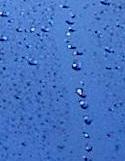|
When two fluids (liquids or gases) are present, the fluid more strongly attracted to the solid surfaces is called the wetting phase. When the preference is strong, the fluid spreads across the solid surface, completely "wetting" the solid surface. In contrast, a non-wetting fluid does not spread across the surface. The wetting behavior depends on the surface and the fluids. To give a common example, water spreads across a dirty car, but beads up once the car is washed and waxed. The water wets the dirty surface but is non-wetting to the waxed surface.
|

|
The photograph shows a waxed car where the waxed surface is water repellent and the water beads up. Typically water wets subsurface soils and aquifer materials (because they're "dirty"). There are examples, however, of water repellent soils (due to waxes derived from plants), and oil-wetted petroleum reserviors. In the majority of aquifer contamination situations, the NAPL is the non-wetting phase.
|